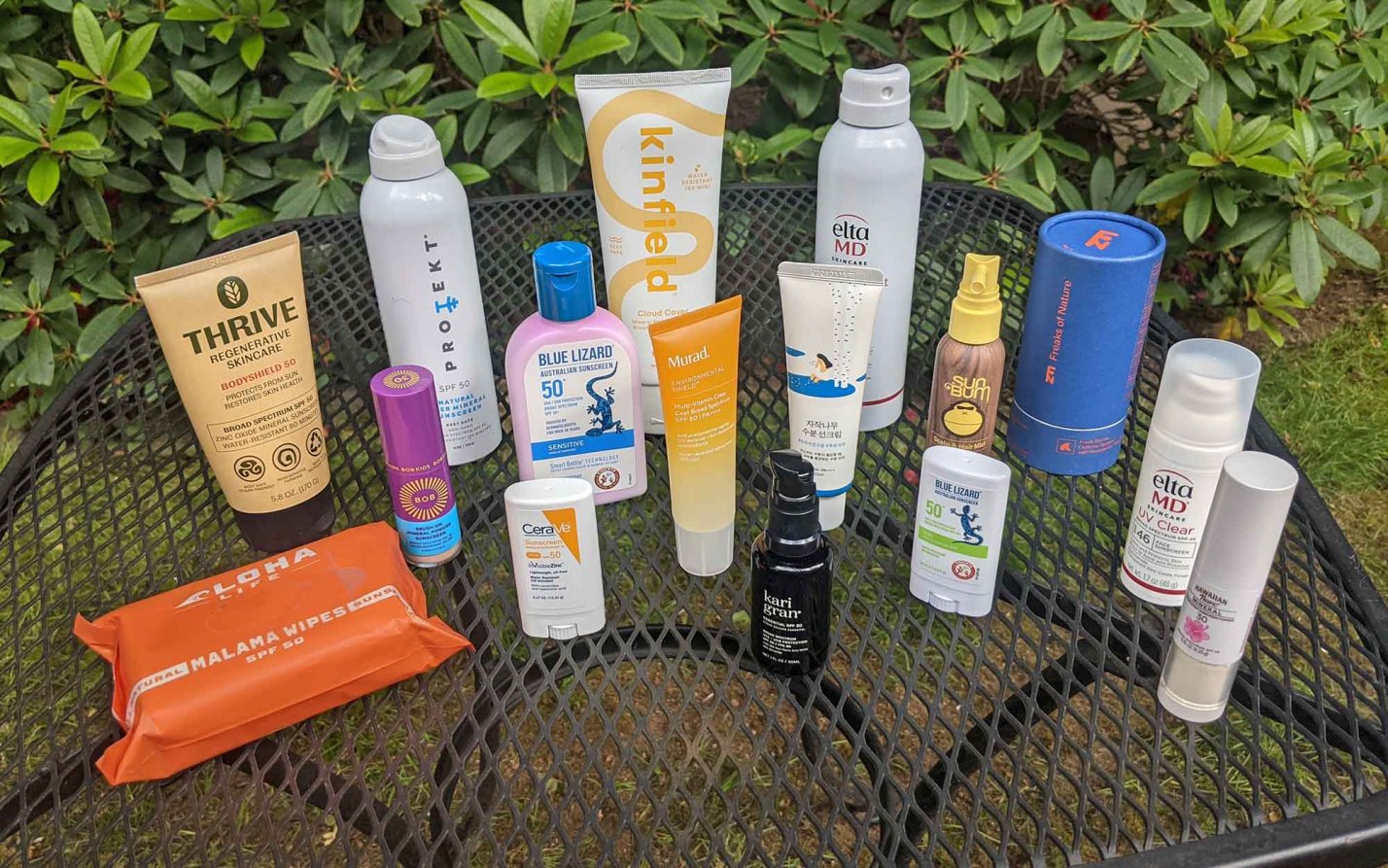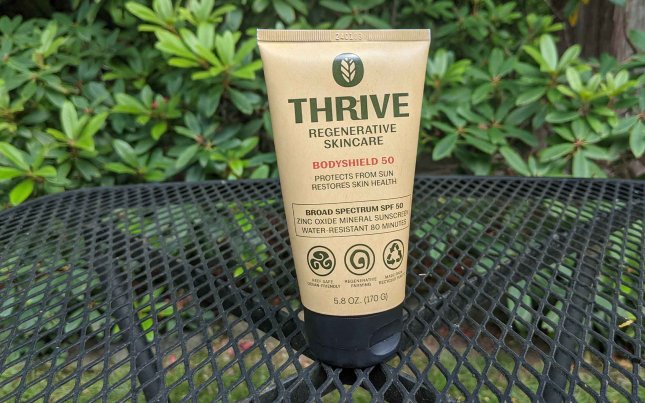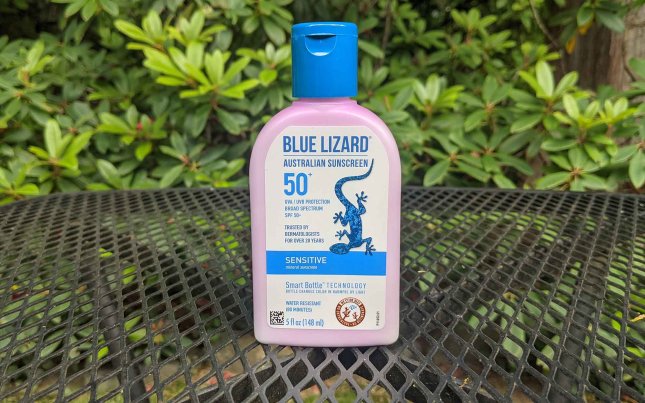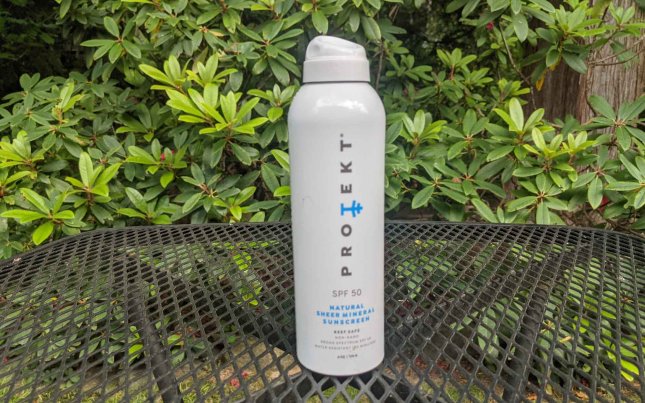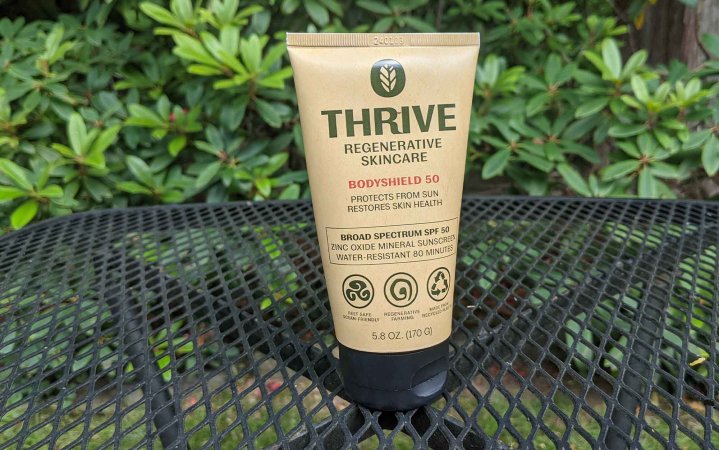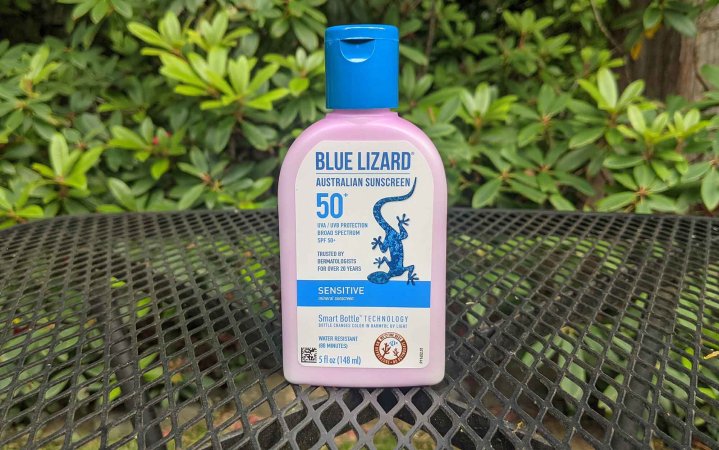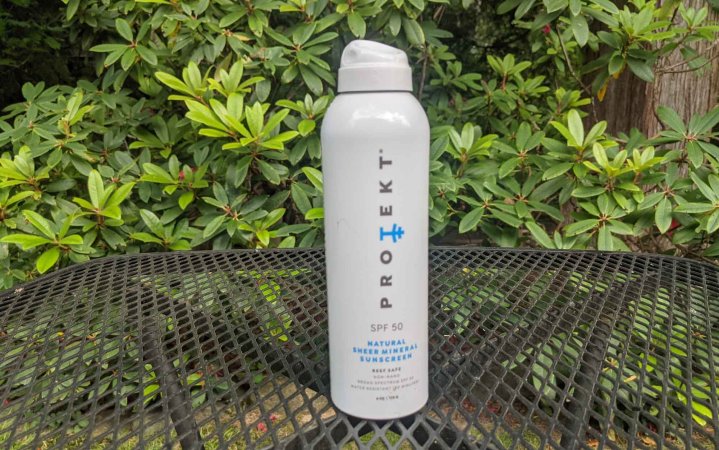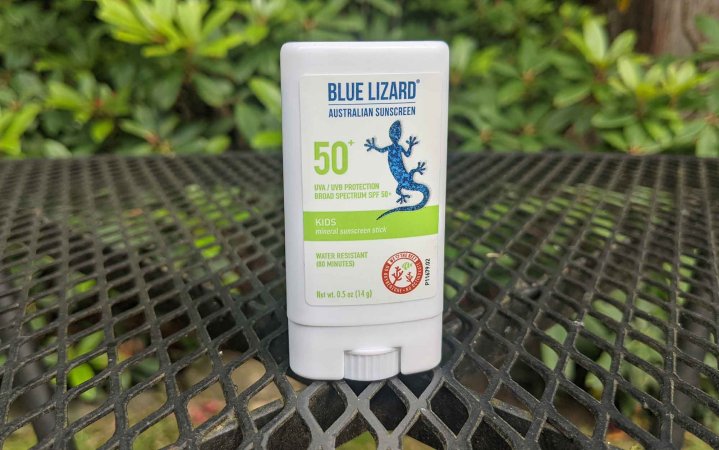We may earn revenue from the products available on this page and participate in affiliate programs. Learn More ›
If you’re anything like me, you probably aren’t using enough sunscreen. That’s partially because most sunscreen isn’t all that pleasant to use, but it’s also because dermatologists recommend making it a daily habit — even for those of us that don’t live in especially sunny climates. Over the last decade the sunscreen market has exploded with lotions, sprays, powders, and sticks, making it that much more likely you’ll find one you are willing to use on a regular basis. I checked out 15 of the most popular products on the market and only four made the final cut for best sunscreen recommendations.
Topics Covered
- Mineral vs Chemical Sunscreens
Jump to Topic ↓ - Sunscreen Reviews
Jump to Topic ↓ - Testing Results
Jump to Topic ↓ - Understanding SPF Ratings
- Jump to Topic ↓
- Sunscreen vs Covering Up
Jump to Topic ↓ - Understanding Ingredients
Jump to Topic ↓
How I Evaluated the Best Sunscreens
Skin is a permeable membrane, so much of my testing time was spent researching what we know about the different ingredients used in sunscreens, and what we know about how they positively or negatively affect human health. I then looked at what the experience was of using each sunscreen — how it felt on my skin, and whether it left a white cast. Finally, I considered the relative price and volume to get a feel for what sunscreens provided the best value.
Mineral vs Chemical Sunscreens
If you’re new to the surprisingly intense world of sunscreen, know that a lot of blood has been spilled over the relative merits of mineral vs chemical sunscreens.
Mineral Sunscreens
The two main active ingredients used in mineral sunscreen are zinc oxide and titanium dioxide. They work by blocking the UV rays of the sun from reaching your skin. These have been used in sunscreen for a long time, with zinc oxide providing more Ultraviolet A protection, and titanium dioxide providing more Ultraviolet B protection. Studies have shown that both zinc oxide and titanium oxide are safe. The downside to these is that they typically leave a greasy, visible (white) residue, which is not aesthetically pleasing. However, in recent years, some zinc oxide and titanium dioxide sunscreens have started using nanoparticles, which reduces these issues. Both of these ingredients have earned Generally Recognized as Safe and Effective status (GRASE) from the FDA.
Chemical Sunscreens
Chemical sunscreens are a little different. Your skin absorbs the active ingredients in chemical sunscreens and then the sunscreen absorbs the sun’s rays. There are a lot of different active ingredients that “chemical sunscreen” can refer to. Here are the most common ones: 4-aminobenzoic acid (PABA), avobenzone, cinoxate, dioxybenzone, homosalate, meradimate octocrylene, octinoxate, octisalate, oxybenzone, padimate O, ensulizole, and sulisobenzone.
Because the chemicals used in chemical sunscreens have been in use for less time, less is known about them. As scientists and researchers have learned more, some have been banned from use. PABA turned out to be a carcinogen, and even increased the likelihood of sunburn in some individuals. Benzene, a known human carcinogen, showed up in tests of sunscreens. More recently, concern has been raised that oxybenzone and octinoxate were bleaching coral reefs, and sunscreens containing these ingredients are banned in Hawaii.
However, because the FDA regulates sunscreen in the United States as a drug, requirements tend to be much stricter here than in the rest of the world where it is regulated as a cosmetic.
Some evidence has emerged that certain chemical ingredients still in use are in fact entering the bloodstream could be harmful to human health. The evidence thus far is limited and the jury is still out, but a recent order from the FDA proposes removing GRASE status from many chemical sunscreens.
I’ll be frank: If it’s important to wear sunscreen, I care more about safety than I do about a little greasiness or white residue. As such, I have prioritized mineral sunscreens in this review, but have included some chemical sunscreens for comparison.
Skin Feel
I don’t like the feeling of anything on my skin — lotion, makeup, bug spray — all of it leaves me wanting to get into a scalding hot shower. But could I become accustomed to the feeling of the sunscreen? I tested each sunscreen by applying a small amount of a few different brands on different sections of my arms and legs and then waiting to see what they looked like and felt like.
Price per Ounce
It’s recommended that the average person use an ounce of sunscreen to apply to all of the skin on their body that is not covered by clothing. That’s a lot of sunscreen. As such, I calculated the cost per ounce of each sunscreen using its list price.
Best Sunscreens: Reviews & Recommendations
Best Overall: Thrive
Pros
- FDA-approved, time-tested active ingredient
- Rubs on easier than other zinc oxide sunscreens I looked at
- No chemical boosters like butyloctyl salicylate
Cons
- Leaves a white cast
- More expensive than my best value pick
Key Features
- SPF: 50
- Water Resistance: Up to 80 minutes
- Price per Ounce: $5.16
- Active Ingredients: 23.5 percent zinc oxide
After researching and learning more about the current state of the sunscreen market, I’m sticking with mineral sunscreens. Given the current lack of research around chemical sunscreens, I’m not comfortable with daily — or more likely for me, seasonal — application of ingredients that are meant to permeate my skin. For that reason, I’m also recommending that you shy away from the newer sunscreens that use nanoparticles, as research into the possible effects of this newer technology is still ongoing. However, it’s worth keeping in mind that even zinc oxide isn’t completely harmless. Despite the label that this sunscreen is reef safe, there is evidence that zinc oxide, even in non-nano form, can harm coral reefs.
Of all the mineral-based sunscreens I tried, Thrive was the least annoying. Which is the best you can say about sunscreen in the end. It was greasy, and it left a white cast, but less so than others I looked at despite its comparatively high (23.5 percent) zinc oxide content. It’s water resistant for up to 80 minutes.
While this one was relatively low in price compared to some of the more premium options out there, keep in mind that, to be effective at its stated SPF, you have to reapply an ounce of sunscreen every two hours. If you’re planning to spend all day at the beach with the family, you’ll easily go through a couple of bottles of this stuff.
Best Value: Blue Lizard Sensitive
Pros
- Affordable
- Mix of zinc oxide and titanium dioxide offers better UVA and UVB protection
- No chemical boosters like butyloctyl salicylate
Cons
- Leaves a white cast
Key Features
- SPF: 50
- Water Resistance: Up to 80 minutes
- Price per Ounce: $3
- Active Ingredients: zinc oxide (10 percent) and titanium dioxide (8 percent)
Another sunscreen that I’ll be keeping on hand in the future is Blue Lizard Sensitive. Unlike Thrive, this sunscreen contains both zinc oxide (10 percent) and titanium dioxide (8 percent). While both types of mineral active ingredients protect against Ultraviolet A — the so-called “aging rays” — and Ultraviolet B — “burning rays” — titanium dioxide does a somewhat better job with UVB, while zinc oxide does a somewhat better job with UVA. Having both in a sunscreen should, theoretically, allow you to maximize the benefits.
In practice, this sunscreen was slightly greasier to the touch than Thrive, and didn’t rub in quite as well. But the difference wasn’t too substantial, while Blue Lizard Sensitive was about half the price. While this bottle comes with an interesting gimmick — it changes color in the presence of UV light — be aware that it is pretty sensitive. When I put it in a semi-shaded window on a cloudy day, that was enough to cause the bottle to change color.
Best Spray: Protekt
Pros
- Uses non-nano zinc oxide
- Water resistant up to 80 minutes
- Affordably priced
Cons
- Bulky compared to lotions
- Still have to rub it in
Key Features
- SPF: 50
- Water Resistance: Up to 80 minutes
- Price per Ounce: $3.80
- Active Ingredients: Zinc oxide (18 percent)
After testing a number of different sunscreens, I wasn’t terribly impressed by the sprays. The packaging is bulkier; they are on the whole more expensive. And then there is that pesky issue of inhalation, especially when it comes to chemical sunscreens. But I get the appeal of avoiding at least some of the greasiness and hassle associated with more typical lotion sunscreens. In those instances, I’d gravitate toward Protekt. Their SPF 50 sunscreen uses non-nano zinc oxide (nano-sized zinc oxide rubs in cleaner to your skin but can produce inflammation in your airway). Compared to Elta MD UV AOX Mist, a mineral-based sunscreen where the efficacy is boosted by the addition of butyloctyl salicylate, it was easier to direct and apply what I meant to. Protekt is also comparative in cost to my best overall and best value pick.

Another reason to steer clear of chemical sunscreens when using spray sunscreens is that it’s actually pretty hard to see how much you are applying. Because they are clear, there isn’t the same visual indicator as there is with zinc oxide or titanium dioxide. And if there is any kind of wind, the odds that your spray is missing its target can be pretty high. In the case of a sunscreen that contains butyloctyl salicylate, there is a double risk for people with an existing salicylate allergy of inhalation in addition to dermal exposure. Other spray sunscreens contain chemicals like homosalate, a known hormone disruptor.
Best Stick: Blue Lizard Kids
Pros
- Less greasy application process than lotions or sprays
- No chemical boosters like butyloctyl salicylate
Cons
- Comparatively expensive
- Application process takes longer
Key Features
- SPF: 50
- Water Resistance: Up to 80 minutes
- Price per Ounce: $17.50
- Active Ingredients: Zinc oxide
Applying 15 different sunscreens to my body really reinforced how much I dislike applying sunscreen. The greasiness. The glop. So I was glad that I tried a couple of stick sunscreens, because I ended up liking them more than I expected. Unlike sprays and lotions, that you have to rub in, with sticks you just make four even passes over all of the exposed skin you are trying to cover up and you are good to go. Of course, in practice, this takes a bit longer than with conventional sunscreen, but it’s nice to have the option to leave my palms clean.

I tried two stick sunscreens: the CeraVe, which uses Zinc Oxide in nanoparticle form along with Blue Lizard Kids. While the Blue Lizard Kids did go on noticeably whiter than the nano version, I didn’t notice a big enough difference to sway me. The slightly higher price and inclusion of butyloctyl salicylate (which will cause an allergic reaction for people with salicylate allergies), make CeraVe a less versatile option overall.
Read Next: Best Sun Hats, Field Tested
The Rest of the Field
I liked the affordably priced Kinfield Cloud Cover sunscreen quite a bit. My only gripe was that it didn’t rub in as well as my best overall pick, and it was slightly more expensive. But if you find this one on sale, it’s a great backup. Less likely to come down in price enough to make it worthwhile is the Freaks of Nature Daily Defender and the Kari Gran Essential, although I liked using these both well enough, and their ingredient list didn’t raise any red flags.
I tested a number of lotions that used either only chemical active ingredients or used them to boost a lower percentage of zinc oxide. Ultimately, I didn’t find the experience of using the chemical sunscreens to be nice enough to compensate for either their higher price point or the unnecessary exposure to chemicals the FDA is on the fence about. While I’m sure r/SkincareAddition will disagree with this take, I would urge outdoor enthusiasts to try to minimize the chemicals they are putting on their bodies before, say, taking a dip in a pristine mountain lake.
I checked out two powdered sunscreens, Bob’s Kids Brush-On Mineral Powder and Hawaiian Tropic Mineral Translucent Sunscreen Powder. While I agree that they are fundamentally more pleasant to apply than greasy lotions, this turned out to be at the expense of knowing whether or not I had applied enough sunscreen. Neither of the bottles made it easy to see how much I was applying, so it was difficult to assess whether I had used enough to achieve the claimed SPF 30 rating.

This was especially true of the one marketed for kids, where it was difficult to even see how much was in the bottle. Applying it in front of a mirror in bright light also made it clear that a lot of the powder was going straight into the air, which means you could be inhaling it. Turns out powdered sunscreens are only recommended as a supplementary sunscreen (after you’ve used a traditional lotion-based sunscreen) for people who don’t want to mess up their makeup.
Malama Wipes are essentially a baby wipe impregnated with sunscreen. I had hoped that this would reduce the amount of greasiness on my hands when I used them, but, unfortunately, this was not the case. The sunscreen smears off of the wipe on both sides, so your hands end up as messy as they do with a typical sunscreen application.

Unlike more classic sunscreen applications, however, it’s difficult to figure out how much you are supposed to use. While the application doesn’t go on clear initially, there is no indication on either the packaging or Malama’s website how much you are supposed to use to achieve SPF 50 coverage. Finally, the active ingredient in these wipes is Tinosorb-M, which has not been approved by the FDA. It is an increasingly common ingredient in sunscreen in other countries, however, due to the fact that it acts like a chemical sunscreen but does not absorb into the skin.
I tried the Sun Bum Scalp and Hair Mist and ended up having mixed feelings. While I appreciate the advantages of using a chemical sunscreen over a mineral one for the purposes of your hairline (this one sprays on completely clear), the idea of spraying chemicals that the FDA hasn’t decided are GRASE so close to where I breathe is enough to give me pause.
Testing Results
Below I’ve broken down the relevant data and testing results for each sunscreen I looked at.
| Product | SPF | Type | Water Resistant | Price | Oz | Price per Oz | Active Ingredients | Rubs in? | Greasy? | Able to Apply the Correct Amount? |
| Thrive | 50 | Lotion | Up to 80 minutes | $30 | 5.8 | $5.16 | Zinc oxide | Yes | Yes | Yes |
| Hawaiian Tropic Mineral Powder | 30 | Powder | No | $19.50 | 0.15 | $130 | Zinc oxide (silica) | Yes | No | Difficult |
| Blue Lizard Sensitive | 50 | Lotion | Up to 80 minutes | $15 | 5 | $3 | Titanium dioxide, zinc oxide | Yes | Yes | Yes |
| Blue Lizard Kids | 50 | Stick | Up to 80 minutes | $8.75 | 0.5 | $17.50 | Zinc oxide | Yes | A little | Yes |
| Sun Bum Scalp & Hair Mist | 30 | Spray | Up to 80 minutes | $17.50 | 2 | $8.75 | Avobenzone, homosalate, octisalate, octocrylene | Clear | N/A | No |
| Kinfield Cloud Cover | 35 | Lotion | Up to 80 minutes | $38 | 7 | $5.40 | Zinc oxide | Yes | Yes | Yes |
| Protekt | 50 | Spray | Up to 80 minutes | $23 | 6 | $3.80 | Zinc oxide | Yes | Somewhat | Yes |
| Aloha Life Malama Wipes | 50 | Wipes | No | $20 | N/A | N/A | Tinosorb-M – not FDA approved | Yes | Yes | Difficult |
| Round Lab Birch Juice Moisturizing Sunscreen | 50 | Lotion | No | $28 | 1.7 | $16.47 | Diethylamino hydroxybenzoyl hexyl benzoate – not FDA approved | Clear | Yes | Yes |
| Elta MD UV AOX Mist | 40 | Spray | Up to 40 minutes | $45 | 5 | $9 | Zinc oxide (butyloctyl salicylate) | Yes | Yes | Yes |
| Elta MD UV Clear | 46 | Lotion | No | $43 | 1.7 | $25.29 | Octinoxate and zinc oxide | Clear | Good | Yes |
| Freaks of Nature Daily Defender | 30 | Lotion | Up to 40 minutes | $35 | 1.7 | $20.59 | Zinc oxide | Not well | Yes | Yes |
| Bob Kids Brush-On Mineral Powder Sunscreen | 30 | Powder | Up to 80 minutes | $28 | .7 | $40 | Titanium dioxide, zinc oxide | Yes | No | Difficult |
| Murad Environmental Shield | 50 | Lotion | Up to 40 minutes | $42 | 1.7 | $24.71 | Avobenzone, homosalate, octisalate, octocrylene | Clear | Yes | Yes |
| CeraVe InvisibleZinc | 50 | Stick | Up to 40 minutes | $10 | 0.47 | $21.28 | Titanium dioxide, zinc oxide (butyloctyl salicylate) | Yes | A little | Yes |
| Kari Gran Essential | 30 | Lotion | No | $66.23 | 1 | $66.23 | Zinc oxide | Yes | Yes | yes |
Things to Consider Before Purchasing the Best Sunscreens
Understanding SPF Ratings
Sun Protection Factor (SPF) ratings represent the additional protection a given sunscreen provides over and above what your skin naturally provides. So if you’d typically start burning in only 5 minutes. SPF 30 will provide you with 150 minutes of protection; SPF 50 will provide 250 minutes of protection.
SPF has been tested, and retested, and retested. That’s the good news. The bad news is that all these tests have come back with different results. However, the reality is that most people don’t apply enough sunscreen onto their bodies anyway — you’re supposed to use a full ounce. That’s a lot of sunscreen. So if you’re worried that your SPF 30 might really be more like SPF 22, I’d start by increasing the amount that you are using, and the frequency with which you reapply before jumping ship to a new brand.
Sunscreen vs Covering Up
Increasingly, people are opting for UPF-rated clothing over exposing excess skin to ultraviolet light. The advantage to UPF clothing is that, unlike sunscreen, you are good to go all day without the need for additional application. Outdoor Life has tested a range of UPF-rated clothing as part of our roundups of the best hiking shirts and best hiking pants.
Read Next: UPF vs. SPF
Ingredients
If you are purchasing from an online retailer, you should be aware that not all sunscreen ingredients have been approved by the FDA — in many other countries, sunscreen is regulated like a cosmetic, which has laxer regulations than over the counter drugs. However, the FDA is likewise considering rescinding the GRASE status of those chemical ingredients that are currently approved. Furthermore, several of the sunscreens I looked at had ingredients that are meant to boost the effectiveness of the SPF, including silica and butyloctyl salicylate, which may produce an allergic reaction in individuals with salicylate allergies. These were not listed as part of the active ingredients list.
FAQs
The FDA recommends using sunscreen with a minimum SPF rating of 15. While they don’t recommend a specific brand of sunscreen, a proposed order would change the ingredients that the FDA generally recognized as safe and effective (GRASE) to only include zinc oxide and titanium dioxide, due to the lack of research around the active ingredients used in chemical sunscreens.
You should use an ounce of sunscreen to cover exposed body parts, and a teaspoon of sunscreen to cover your face.
While the active ingredients used in mineral sunscreens — zinc oxide and titanium dioxide — have been around for decades and are well understood, chemical sunscreens are another matter. In recent years, certain chemical ingredients have been taken out of sunscreens as a result of growing concerns about their safety. PABA was banned in several countries, and is not considered GRASE in the U.S., due evidence that it produced rashes and could produce photosensitivity in some people. Oxybenzone, avobenzone, octocrylene, and octinoxate damaged coral reefs and is now banned in Hawaii. The FDA has indicated that they may change their recommendations in the future as a result of a lack of scientific research.
Final Thoughts on the Best Sunscreens
If it’s been a minute since you last changed your sunscreen brand, it can be overwhelming to consider the sheer number of options there. After testing and researching the ingredients of leading brands, it’s clear to me that zinc oxide and titanium dioxide are still the best options around, although individuals may want to steer clear of the nanoparticle versions of these ingredients in spray versions of sunscreen. Until then. Here are my top picks for the best sunscreens.
- Best Overall: Thrive
- Best Value: Blue Lizard Sensitive
- Best Spray: Protekt
- Best Stick: Blue Lizard Kids
